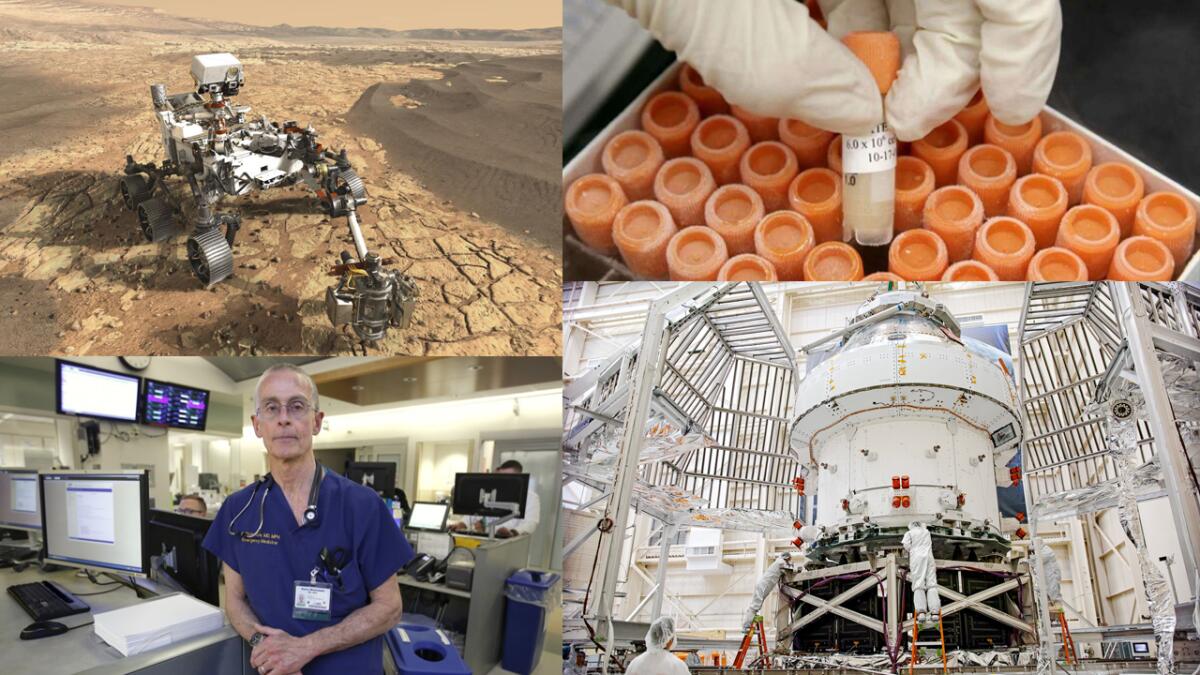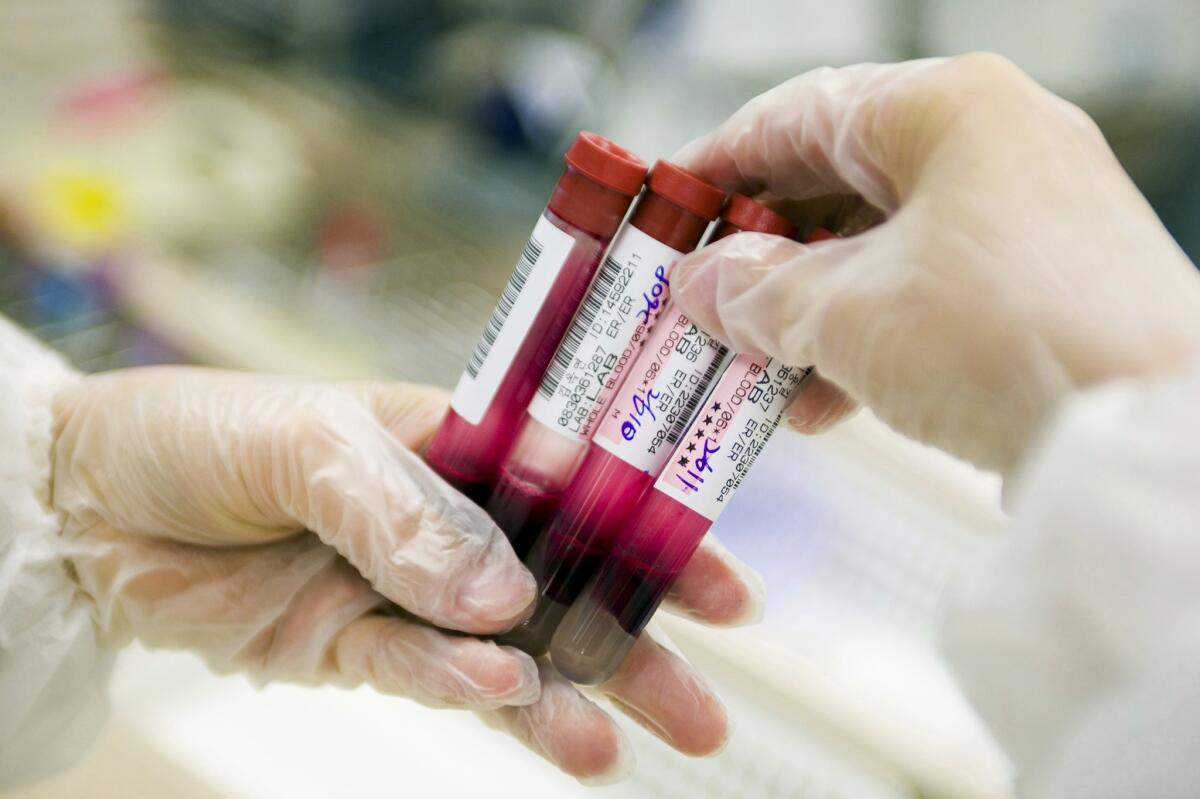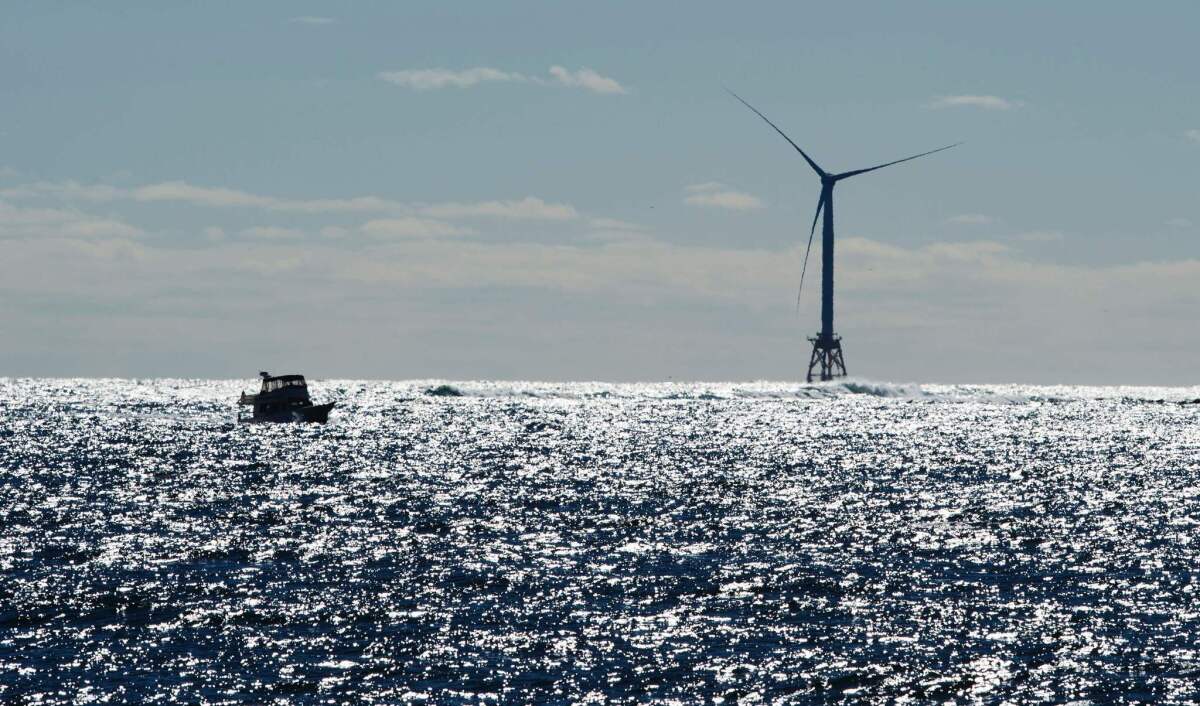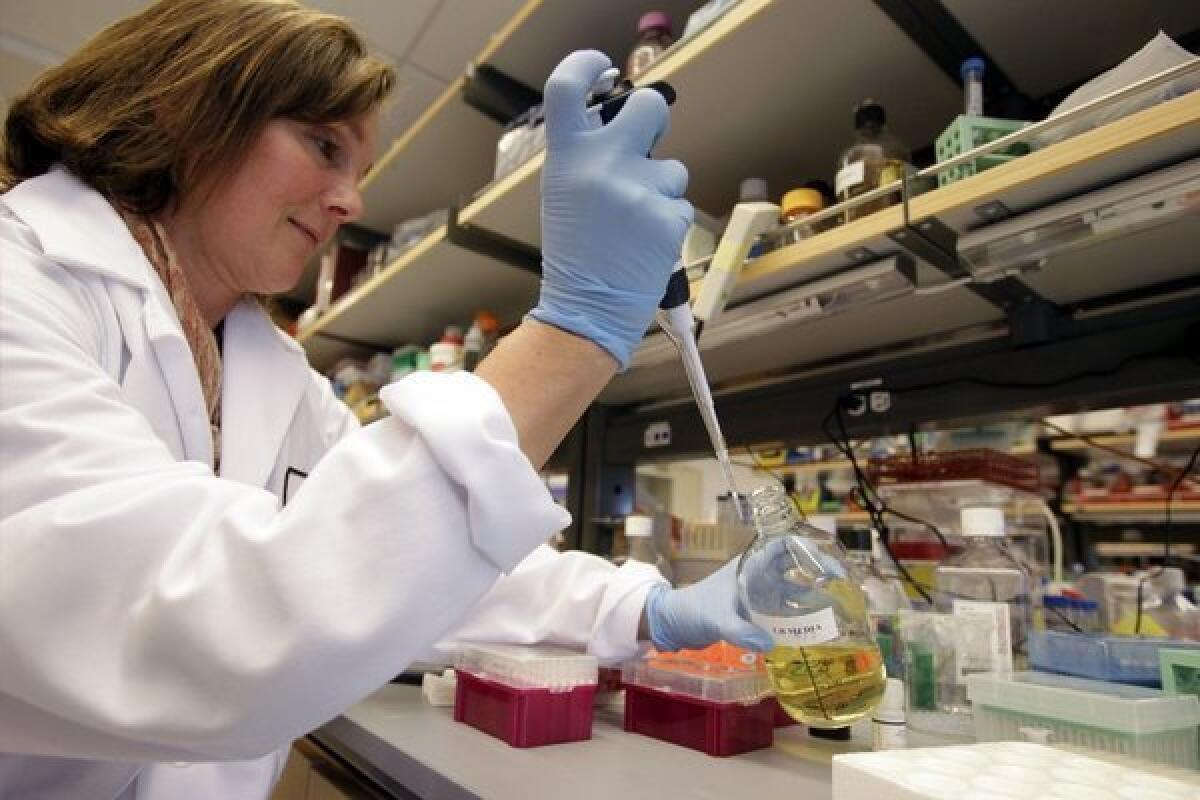Eight science stories to watch for in 2020

- Share via
It will be a year of looking outward, as scientists send spacecraft to the moon, Mars and beyond.
It will also be a year of looking inward, to study cells that can signal disease — or cure it.
In between, researchers will focus their attention on Earth and its changing climate. And that’s just a sampling of what’s in store for 2020.
Here’s a look at some of the science stories we’re looking forward to in the new year.
Mars will be the ‘It’ destination
Mars is the go-to spot for space exploration in 2020.
NASA will send its newest rover — known as Mars 2020 — to the red planet in July or early August, depending on launch conditions at Cape Canaveral in Florida. Once the rover lands at Jezero Crater in February 2021, it will join Curiosity in its quest to determine whether life could have existed on Mars. But unlike Curiosity, which is looking for signs that Mars was habitable in its warmer, wetter past, Mars 2020 will search for direct evidence of ancient microbial life. To do so, it will travel up to 12 miles over the course of at least one Martian year. (That’s about 687 days on Earth.)
The NASA vehicles can expect company. The ExoMars mission, a collaboration between the European Space Agency and Russia’s Roscosmos, will be launching its own rover in the summer of 2020 to hunt for indications of past Martian life. Rosalind Franklin, as the rover is known, will reach Mars in March 2021. Planners hope it will travel several kilometers during its working life.
The United Arab Emirates will be getting into the act too. The Emirates Mars Mission, known as Hope, will launch in July and study the Martian atmosphere from orbit. About the same time, China will reportedly attempt to launch a trio of spacecraft — an orbiter, a lander and a rover — as part of its Huoxing-1 mission.
— Karen Kaplan
Stepping up the hunt for early signs of cancer

Scientists have been searching for ways to detect cancer in its earliest stages, when treatments are most likely to be effective. In 2020, they’ll be harnessing the power of biomarkers to aid them in this mission.
Biomarkers are distinctive bits of protein or DNA that can be detected in bodily fluids like blood and urine. The trick is to identify ones that are reliable signals of malignancy. Candidates are being tested in ever-larger groups of people to determine whether they’re accurate and can be trusted not to generate too many false-positive results.
Leading the pack is a “liquid biopsy” called CancerSEEK. Pioneered at Johns Hopkins University, this potential screening test was able to find signs of five types of cancer — ovarian, pancreatic, liver, stomach and esophageal — for which no early-detection tests currently exist.
The National Cancer Institute recently unveiled a blood test of its own that searches for certain antigens produced by the body in response to cancer. This strategy has already shown promise as a way to detect cancers of the breast, lung, liver, colon and pancreas. Large trials will soon get underway; if successful, a biomarker test could make its way into clinics within four or five years, experts predict.
— Melissa Healy
Orion’s first flight around the moon
In late 2020, NASA’s Space Launch System rocket is expected to blast off from Kennedy Space Center, using 8.8 million pounds of thrust to send the Orion spacecraft on its first voyage around the moon.
The three-week mission, known as Artemis I, is the first step in the space agency’s ambitious plan to send the first woman and the next man to the lunar surface by 2024. The uncrewed test flight will carry Orion 280,000 miles from Earth and allow engineers to ensure systems on the rocket and the spacecraft are working correctly.
Along for the ride will be 13 miniature spacecraft known as CubeSats, each tasked with a separate mission. For instance, the Near-Earth Asteroid Scout will image the smallest body ever explored by a spacecraft — an asteroid just a few meters across. NEA Scout will also carry the largest light sail to ever be tested in space, stretching out a remarkable 328 square feet when fully unfurled.
Other CubeSats include CuSP, a space weather station just a bit bigger than a box of cereal, and Lunar Flashlight, which will look for ice deposits on the moon. Any trip to space, even a test flight, is a great time to do science.
— Deborah Netburn
A new round of climate commitments

It’s time for the rubber to meet the road as countries update their initial pledges under the Paris climate accord. So far, 79 nations have indicated that they plan to announce stronger efforts in 2020, and two have already submitted new targets.
Current commitments — officially known as Nationally Determined Contributions, or NDCs — will not deliver the goal of limiting global warming to less than 2 degrees Celsius above pre-industrial temperatures. Indeed, a recent assessment by the Climate Action Tracker said the world is on track for almost 3 degrees of warming by 2100.
It’s unclear how much that will change next year. Most of the new pledges will come from small countries that contribute little to warming, said Taryn Fransen, a climate policy expert at the World Resources Institute, which maintains the ClimateWatch NDC tracker. “The big question for this coming year is whether we’ll see a similar level of commitment from larger countries,” she said.
No one is expecting much from the U.S. — the biggest historical emitter of greenhouse gases — since President Trump has already begun the process of leaving the Paris deal. Japan and Australia have also hinted that they will not increase their ambitions. On the other hand, the European Union — the world’s third-largest emitter — recently voted to become carbon neutral by 2050.
The big unknowns are the other major players like China and India, and their moves in 2020 will likely depend on global politics — including the outcome of the U.S. election, which will determine whether America fully abdicates its role as a global climate leader. That “could certainly have implications for what they do,” Fransen said.
— Julia Rosen
Voters will decide the future of California’s stem cell agency

In the 15 years since voters approved Proposition 71, the California Institute for Regenerative Medicine has awarded billions in stem cell research grants, lured top-notch scientists to the state, built state-of-the-art facilities and funded 60 clinical trials. A CIRM-funded treatment developed at UCLA has led to a cure for dozens of children who were born without a functioning immune system.
All of this was made possible by CIRM’s initial allocation of $3 billion. Now that money has been spent, and voters will be asked to renew their commitment to stem cell science by approving a $5.5-billion ballot initiative in November 2020.
As before, the new money would fund both basic research and more focused projects that could pay off big but are generally too risky for private investors. But the new ballot measure would deviate from Proposition 71 by setting aside funds to train students for careers in regenerative medicine. It would also establish a task force to insure that the taxpayers who funded CIRM can afford the treatments made possible by the agency’s grants.
Many of the institute’s structural problems would remain in place, however. CIRM would continue to operate without meaningful legislative oversight, and its board of directors would still be populated by people from research institutions and disease advocacy groups who have built-in conflicts of interest. We’ll see in November how voters weigh the pros and cons.
— Karen Kaplan
A green light for gun research
For the first time since 1996, the coming year will likely see the federal government underwriting research on firearm violence and injury prevention. A provision inserted into an end-of-year spending bill in the House of Representatives would set aside a total of $25 million for the National Institutes of Health and the Centers for Disease Control and Prevention to fund research on issues like safer gun ownership, violence and suicide prevention, and the impact of policy initiatives on gun-related injuries.
Congress had already issued clarifying language aimed at overturning the 1996 Dickey amendment, which forbade the use of federal funds for research that could be used to advocate for gun control. The new action in the House comes against the backdrop of escalating mass shootings, and observers expect it to pass the Senate.
For a field that’s been starved of federal funds for more than 20 years, it’s a start. Health researchers interested in studying the impact of guns on injuries and deaths had largely moved on to other pastures, and the paucity of money discouraged younger academics from pursuing such lines of study.
But organizations like the UC Davis Firearm Violence Research Center, which has been bankrolled by the state and philanthropic organizations, have begun to incubate a new generation of researchers. An infusion of federal funds could mean a renaissance in gun research.
— Melissa Healy
Earth Day turns 50

Environmentalists will be celebrating the 50th anniversary of Earth Day in 2020. The annual event began on April 22, 1970, when an unprecedented 20 million people turned out for what was billed as a nationwide teach-in on issues like pollution and pesticides. Today, it’s credited with launching the modern environmental movement and paving the way for landmark U.S. laws like the Clean Air Act and the Endangered Species Act.
Despite those successes, the threats to the planet are more dire now than they were 50 years ago. Climate change, deforestation and plastic pollution, among others, endanger ecosystems and societies around the world.
In response, the organizers of Earth Day 2020 are planning massive cleanup efforts and tree plantings throughout the year. But the central focus of this year’s April 22 event will be a joint campaign with youth activists to push for stronger climate action. Scientists say society must slash emissions by 2030 to meet global climate goals.
“Earth Day 2020 marks the beginning of the last crucial decade,” said author and activist Bill McKibben. Time will tell whether this Earth Day can have the same kind of impact as the first.
— Julia Rosen
Bringing home the asteroids
It’ll be a banner year for asteroid sample missions. NASA’s OSIRIS-REx mission has been mapping the asteroid Bennu since late 2018. In August, it will make a daring maneuver to swoop down to the surface and gather a sample of the space rock during a five-second rendezvous. When OSIRIS-REx returns to Earth in 2023, it will become the first U.S. mission to bring home samples from an asteroid.
But it won’t be the first in the world. Japan’s Hayabusa spacecraft sent back dust from the asteroid Itokawa in 2010, though a series of technical glitches cut the hoped-for sample of several grams to less than a milligram.
A decade later, its successor Hayabusa2 is bent on a bigger payday. The spacecraft left the asteroid Ryugu in November after blowing a small crater into the surface to collect more pristine samples. If all goes smoothly, Hayabusa2 will reach Earth by December 2020.
Asteroids may be small, but studying them could help scientists unravel some big mysteries. The space rocks are fossils from the birth of the solar system some 4.6 billion years ago — celestial fragments that never managed to grow into planets. Their contents may hold clues about our own origins, since asteroids may have seeded Earth with some of the chemical precursors needed for life to arise.
— Amina Khan











